This fermented honey garlic is the perfect thing to make to boost your immune system! Both honey and garlic have strong medicinal benefits, so you’ll want to have this delicious home remedy on hand for cold and flu season.
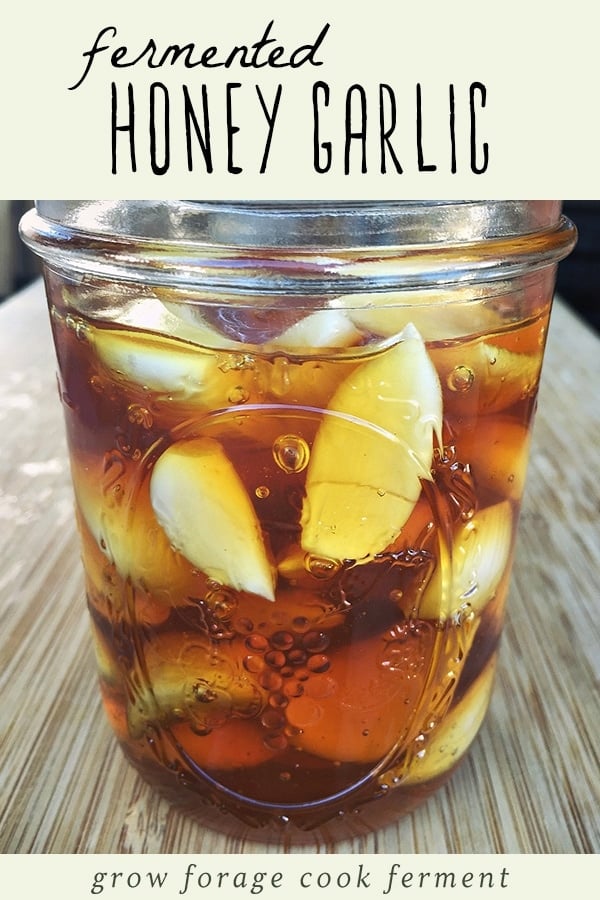
Want to save this post for later?
Fermenting Garlic in Honey
I’m really excited to share this post with you! Fermented honey garlic is something I’ve been wanting to try for a very long time, ever since I first read about it on the Killer Pickles blog.
I usually reserve my honey for mead making, but using it for other ferments intrigued me. Don’t ask me why I haven’t done it until now, because it’s the easiest thing in the world!
This tasty fermented garlic in honey can be used for many things, as good food and good medicine. Honestly though, I like to just eat it as is!
Fermented Honey Garlic Recipe
Making fermented honey garlic is so easy, it hardly needs a recipe!
Prepare the Garlic
The hardest and most time consuming part is prepping all of the garlic. Whatever size jar you use, you’ll want to fill it about 1/2-3/4 full of peeled garlic.
The quickest and easiest way to prep garlic is to place the side of a chef’s knife on top of a single clove and then give it a firm whack with the palm of your hand.
Don’t do it too hard, as you don’t want to crush the garlic, but just enough to lightly bruise the it. This will make it easy to peel, and will also release a bit of the garlic juice.
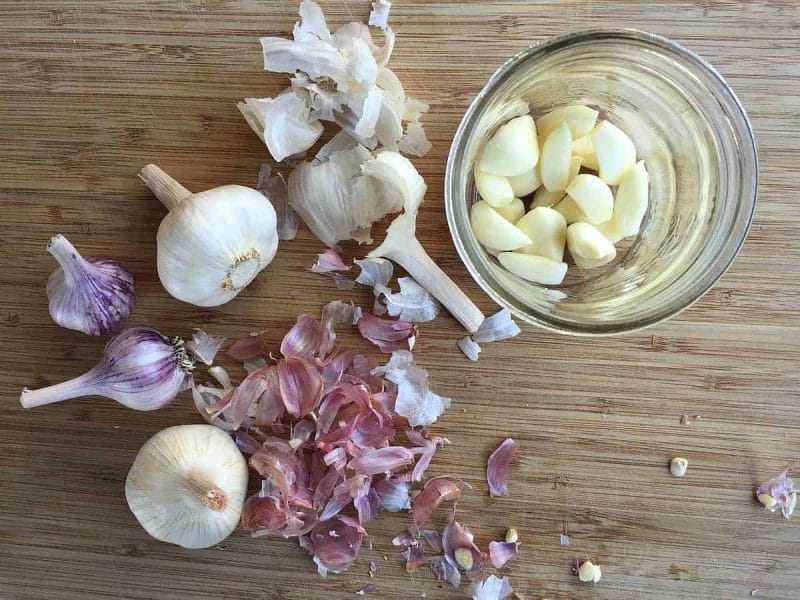
Add the Honey
Once you have enough garlic in your jar, pour in some raw honey to cover it. The garlic will probably float a bit and that’s ok.
It’s important to use raw honey to make fermented garlic in honey, as it will still have all the bacteria and wild yeast that is necessary for fermentation.
When liquid is added to honey, it jump starts the fermentation process. The small amount of juice from the garlic will create just enough liquid for fermentation to happen.
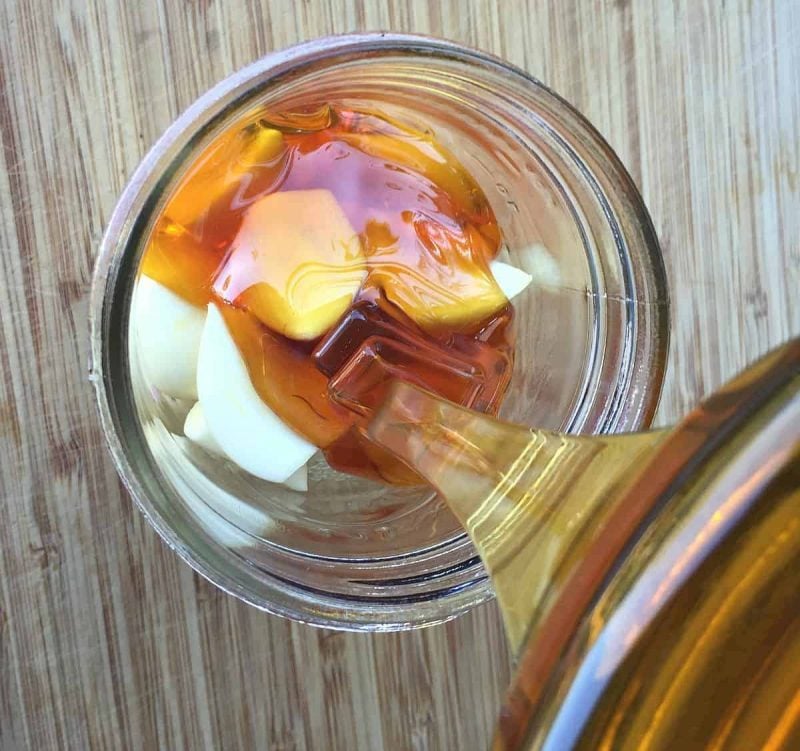
Cover and Flip
Cover the jar loosely with a lid to let the gasses escape, and put it in a dark place to ferment.
It’s a good idea to put a plate or something similar underneath the jar as it’s fermenting, as it will likely bubble up a bit and a little honey could possibly drip out.
It’s also important to gently turn the jar over every day or so, or whenever you think about it, to make sure that all of the garlic stay coated with honey.
Screw the lid on tightly before you do this! Then return it to it’s upright position and re-loosen the lid.
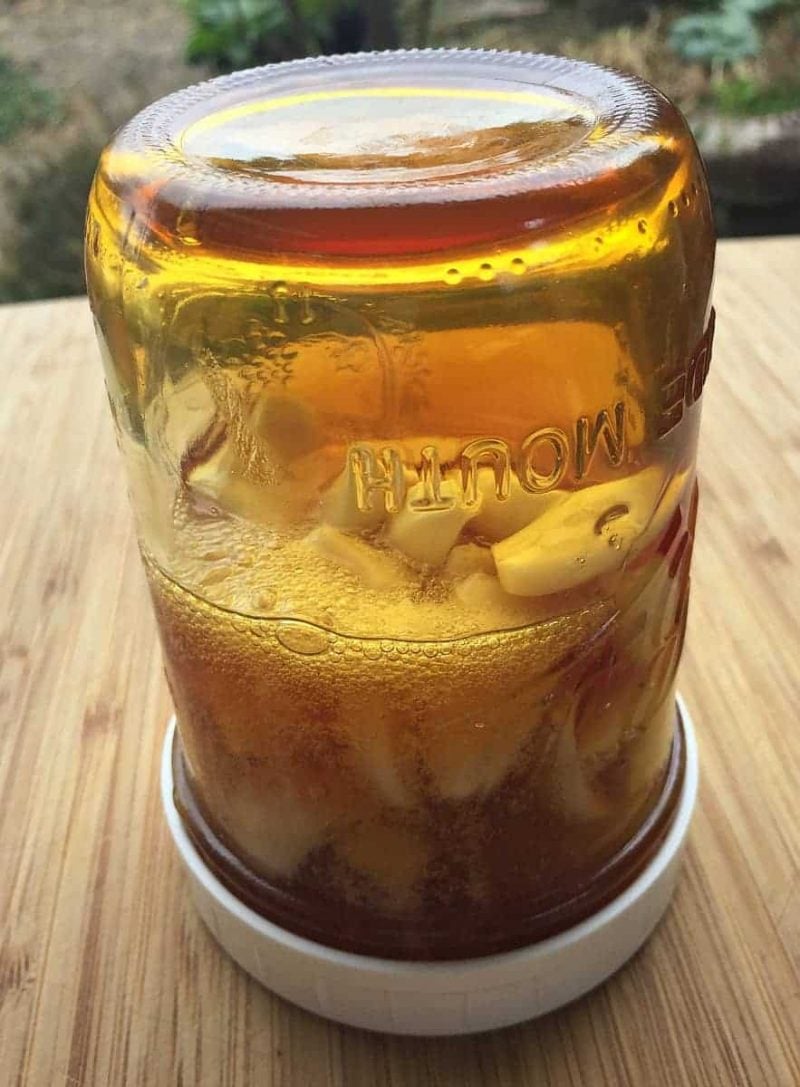
In a few days to a week you will notice some bubbles forming on the surface of the honey. Hooray!
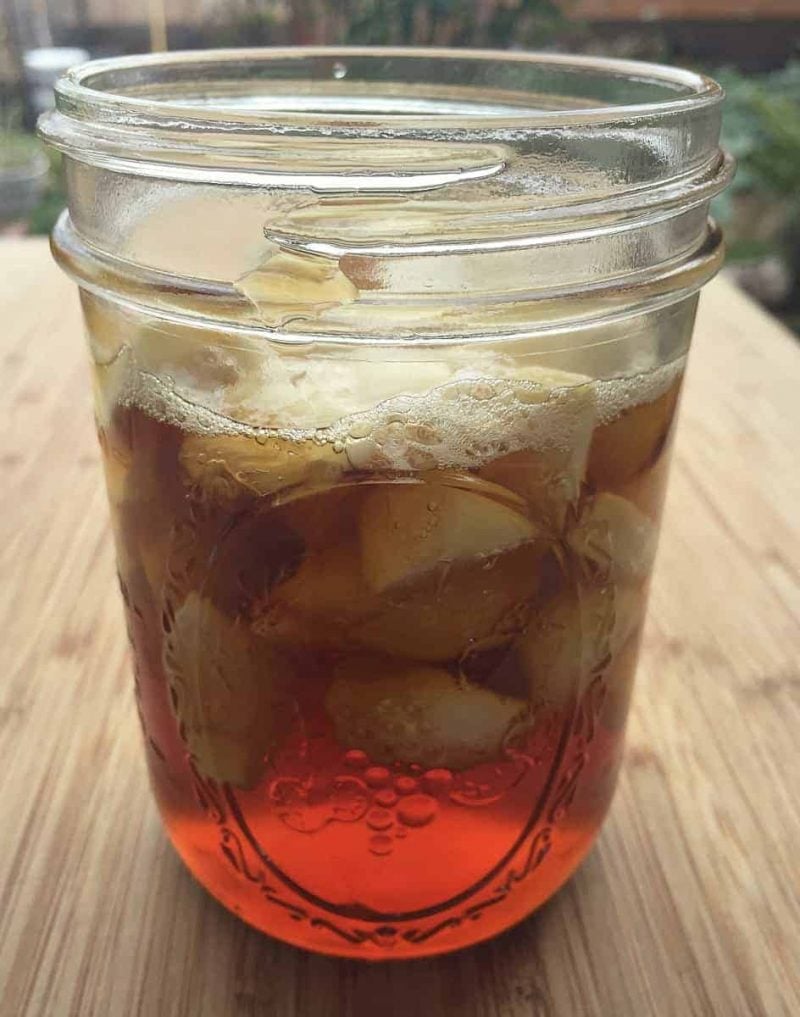
The honey garlic will ferment for about a month, but you can eat it at any time during the process.
The flavor will continue to develop over time, the garlic will mellow, and the honey will become much runnier.
Occasionally the garlic cloves turn a blue or green color due to a reaction during the fermentation process. While it may be a bit alarming, it is not harmful and the honey garlic can still be used.
Honey garlic will store well in a cool place for many months, or even a year or longer! I’ve kept some for over two years and it is still good.
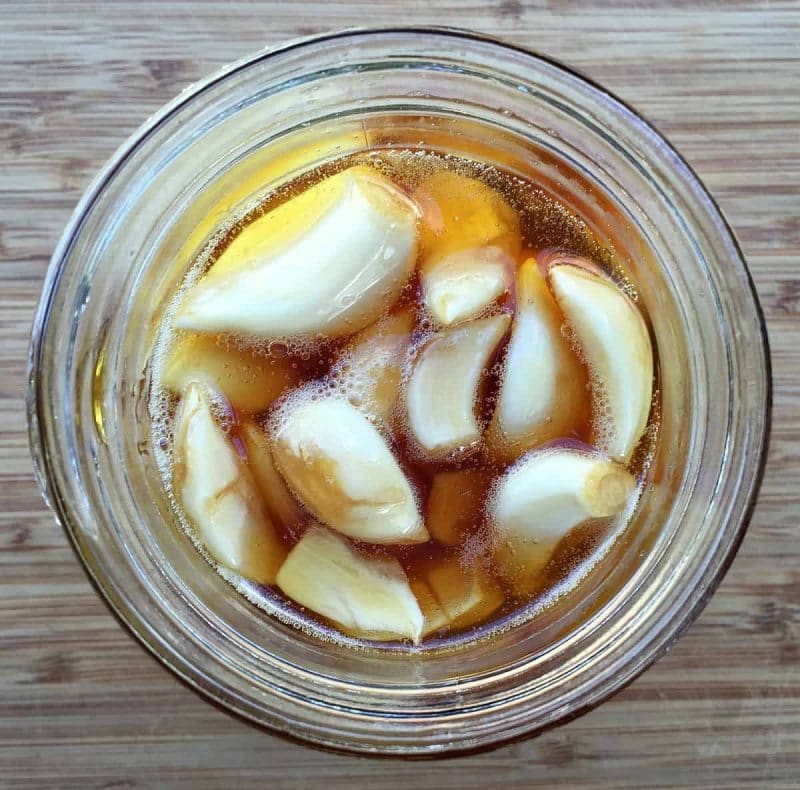
Using Fermented Honey Garlic
Now, how do you use this fermented honey garlic? That’s a good question, and it can be used in a variety of ways.
Both garlic and honey have strong medicinal properties, so it makes sense to use it as an immune booster or if you feel a cold or flu coming on.
Pop a whole garlic clove, or take a spoonful of honey (or both!).
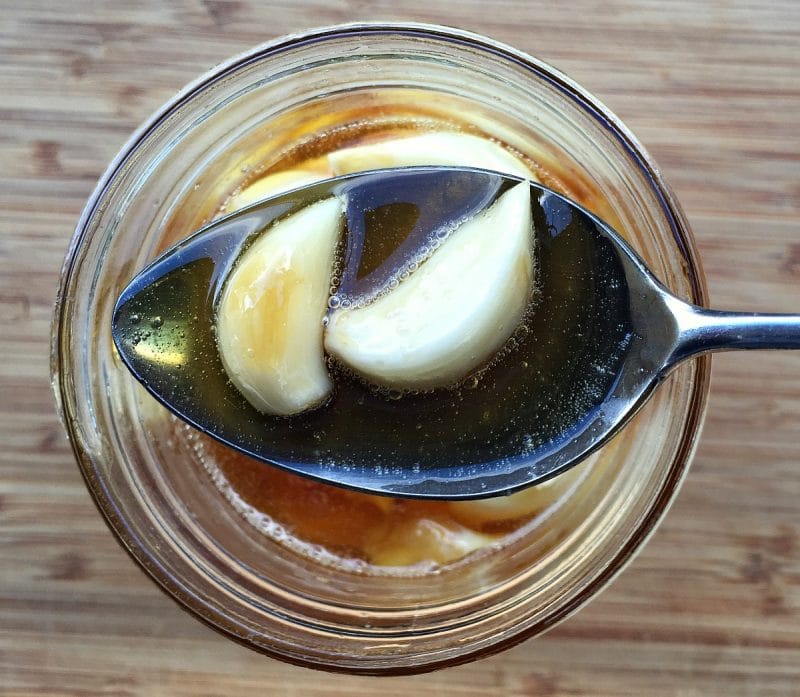
As you can probably imagine, honey garlic also makes a wonderful food!
It’s a natural in marinades and sauces, and would make a really tasty glaze for meats or veggies. Basically anything where you would normally use honey and garlic together!
Is Botulism a Concern in Honey Garlic?
I get this question a lot about fermented honey garlic! The short answer is no, botulism is really not a concern in this type of ferment.
While botulism can happen in garlic and oil preparations without added acidity, the fermentation process that happens here makes it very unlikely.
Raw honey is acidic, and while it can carry botulism spores (which is why it is not recommended for babies under 1 year), the level of acidity stops them from reproducing, which is what causes botulism.
If you are concerned about it, use a pH test strip. Botulism spores can’t reproduce with a pH of less than 4.6. Honey is usually around 3.9, but that can vary between brands.
If the pH is too high, add a splash of raw apple cider vinegar to add more acidity and retest. This is generally not needed, but I did want to mention it.
Honey garlic should not be given to babies under one year of age.
I really hope you make this yummy honeyed garlic! It’s super easy, and great to have on hand. I have a feeling it’s going to become a staple in our house!
Have you ever made fermented honey garlic? How do you use it?
More Fermented and Infused Honey Recipes
Enjoy these other recipes that showcase fermented and infused honey!
- Fermented Honey Cranberries
- Fermented Elderberry Honey
- Herbal Infused Honey
- Lilac Flower Infused Honey
Fermented Honey Garlic
Equipment
Ingredients
- 1 cup whole garlic cloves peeled and slightly crushed
- 1 cup raw honey or more, as needed to cover garlic
Instructions
- Place the peeled garlic cloves into a wide-mouth pint sized mason jar. Add enough honey to completely cover the garlic cloves. Make sure they are coated with honey.
- Place the lid on the jar loosely, then tuck into a dark place.
- Every day or so, tighten the lid on the jar and flip it upside down to coat the garlic cloves with honey. Loosen the lid again when you return it to the upright position.
- Within a few days to a week, you should see small bubbles start to form on the surface of the honey.
- The honey garlic will ferment for about a month, but you can eat it at any time. The flavor will continue to develop over time, the garlic will mellow, and the honey will become much runnier.
- Store in a cool place for many months or even a year, if not longer.
Notes
- It’s important to use raw honey for this recipe, as it has all of the bacteria and wild yeast that is necessary for fermentation.
- The small amount of juice from the garlic will create just enough liquid for fermentation to happen.
- It’s a good idea to put a plate underneath the jar during fermentation, as it will likely bubble up and a little bit of honey could possibly drip out.
- Occasionally the garlic cloves turn a bluish or greenish color during the fermentation process. While it may be a bit alarming, it is not harmful and the honey garlic can still be used.
- If you are concerned about botulism, use a pH test strip. Botulism spores can't reproduce with a pH of less than 4.6. Honey is usually around 3.9, but that can vary between brands.
- If the pH is too high, add a splash of raw apple cider vinegar to add more acidity and retest. This is generally not needed, but I do want to mention it.
- Honey garlic should not be given to babies under one year of age.

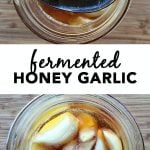
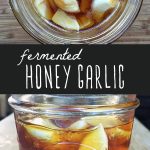
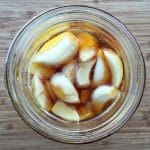

Hello, I’m trying this recipe out for the first time. Does it make a difference in the fermentation process if the garlic ends were cut when peeled? Does having a little exposure to the inside of the garlic enhance the fermentation? Could freshly minced garlic be used for the same process and if so would it accelerate the fermentation process?
Yes, you can totally cut, crush, or mince your garlic. I can’t say for certain if it’ll enhance or accelerate the fermentation in any way, but it might!
I’m doing my first ferment in a smaller jelly hat just to experiment. I burp it daily and turn it afterwards. But the heat does have a bit of honey on it and around the room of the glass. At what point could I wipe that down? I’m stairs to rinse the jar off even tho the lid is on nice and tight. I didn’t put paper in the lid. Thanks!
I’m not sure what you mean by the heat having a bit of honey on it. Do you mean the rim of the jar? If it’s on the outside, it should be fine to rinse off. I wouldn’t rinse the inside of the glass jar.
The garlic turns green or blue because it is old or immature.
That’s not the only factor for garlic turning green or blue. It can also change color due to a change in pH or a reaction to the fermentation process.
Hi!
I am trying this recipe, but I don’t have any weights to keep the garlic down. Will the garlic naturally sink? Should I go find a weight? I am worried I will ruin this batch.
You don’t need weights for this recipe. Daily, you’ll need to flip your closed jar to resubmerge the garlic to be sure it’s completely coated in honey.
Can I can this fermented honey either by bwb or pressure cook?
No. Canning would destroy the good bacteria in the raw fermented honey. Fermented honey can last for a year or longer as is.
Hey, I was wondering exactly what you meant by raw honey, I have honey that I bought locally and I just called to ask them if it was raw and the woman told me it’s unfiltered but it was heated slightly in order for it to stay liquid in the jar, is that honey I could still use for this or no?
Raw honey is unpasteurized. It’s either never been heated or never heated above 96 degrees. It’s hard for me to know if it’ll work without knowing the temperature it was heated to. Sorry!
actually, bees keep their hives around 96°F year round. honey that is heated beyond that is no longer raw honey.
Please can this kill a bacteria called h.pylori
I’m sorry, I’m not sure.
Hi
Thanks for the recipe! When I did this I never saw it bubble. The honey is very liquid and smells rich and garlicky. It’s been 3 months. Any worries about no bubbles?
Did you use organic garlic and raw, never heated honey? If not, it may not have fermented. It’s still useable, it just means it’s infused honey and not fermented.
I only wish I had known about this recipe in spring when so many people around me needed cough and symptom relief here in NYC!
I’m making this for friends and family for the holidays for health & for healing. The fermentation will be 2 weeks only at that point. Do you think I’ll need to give them instructions to burp or can I gift these babies with “keep in a dark cupboard” 2021?
The bubbles are brewing nicely, btw, and i have food-grade glass weights to keep the garlic cloves down. I added a few drops of apple cider vinegar because I’m a newbie and didn’t want to cause fermentation fright.
Hi Marnie! Honey garlic definitely makes a great gift! At that point burping will most likely not be necessary, but you may want to mention it to them just in case.
Hi, I have had my garlic honey process going for over 6 weeks now to your recipe discription, But when I eat a clove I still get quite a strong / sharp garlic taste.
How can I improve this?
Room temp maybe?
The other thing is that the cloves are becoming quite wrinkly. Is this normal?
Thanks in advance😁
Hi, Martin. It’s totally normal for the garlic cloves to become wrinkled. You’ll notice over time they’ll turn brown, which is also perfectly normal. I can’t speak to why your garlic still has a sharp flavor. Did you use raw honey and organic garlic?
Hello, How long will this last? Thx.
It can last a year or more.
Is it ok to use minced garlic instead of whole cloves?
Thanks! Can’t wait to make for Christmas 🎁
Hi Rose! Yes, using minced garlic should still work. Happy Holidays! ❄
I made a jar of honey fermented garlic last year and it’s still good! Just a thought – I’ve also made your honey fermented cranberries which are great and having eaten a slice of the ginger from there, wondered if you could ferment thin slices of ginger in the same way? Or even add ginger to the garlic? 😁
You definitely could! The possibilities are endless.
Can this be made with raw honey that has crystallized?
Yes, but I would smooth out the raw honey prior to using.
This recipe intrigues me! Can you add ACV to this? If so, how much would you add for a pint jar? I bought my honey at a health food store, but I’m not really sure if I can trust the label on my honey. It says “Pure, Local, Raw”. Doesn’t say whether it’s been pasteurized. But I”m going to try the honey/garlic only for now.
I would remove a portion of the fermented honey and make a vinaigrette with it and some ACV.
Thank you for the recipe! It worked! I just wonder if we could reuse the honey used for fermenting when we finish a bottle and put in fresh garlic again to keep the fermentation going or what can I use the used up left over honey from the bottles?
Appreciate it!
It’s advised to start a new batch of fermented garlic honey as there can be a risk of cross-contamination between the fresh and old honey.
I forgot to loosen the lid after turning the jar and it was all bubbly and released gases after opening it up. Is it still safe to eat?
Yes, those built-up gases mean that it is fermenting properly.
Thank you!
Hello, I made one of these last year, or a year and a half ago, and it was good for a while. Then the garlic and honey started to darken a lot. The garlic started to look like black garlic and the honey deepened to almost the color of maple syrup. I used local honey as well as garlic from my farmer’s market. I started cooking more recently, and noticed the jar behind something. It smells good and I’d hate to throw it.
I have honey garlic from several years ago. It’s still perfectly edible even when the cloves of garlic darken.
Hi. after 2 weeks my honey is crystallizing. Too cold? Any ideas?
It may be too cold where you have it fermenting.
Can I use “ fresh peeled” packaged garlic from the grocery store
Yes, as long as they’re organic, they should still ferment.
When can you tighten the lid for storage? And do you remove the cloves at any point? Some of my cloves look more brownish. Thanks
You can remove them if you want, but they’ll be fine in the honey for a year a more. I tighten the lid down after at least a month of fermenting.
At what point does one finally tighten the lid for storage? After the bubbles start forming? After the month that is estimated for the fermentation to take place?
Thank you!
It doesn’t require refrigeration. I let mine sit on a shelf in my pantry with the lid closed after a month of fermentation.
Does it have to be a glass container or could you use a plastic container with a screw top?
Yes, you can use plastic.
It’s not the acid, it’s the air. Clostridium botulinum, the organism that produces the toxin, is an obligate anaerobe which means that it cannot grow in the presence of air (oxygen). Adding vinegar doesn’t hurt anything, but it is exposure to air that prevents the bad bug’s growth and toxin production.
Can you use honey with the comb? Will the beeswax effect fermentation?
No, honey with the comb should work fine.
Hi, I really enjoyed your recipe. I live in Iran and my job is to produce raw honey. Sorry, I can not access your book. If you have other recipes for raw honey products, please send me the link.
Hi there, you can find more raw honey recipes on my website here: Fermented Elderberry Honey
And another one here: Fermented Honey Cranberries
Could I used a ratio of pasteurised ed honey and raw honey, and do you know if it is as safe to consume if it is made only with pasteurised honey? (Obviously it’ll lack some of the fermenting properties but in terms of consumability)
The garlic will only ferment with raw, unpasteurized honey. Using pasteurized honey doesn’t make it safer to eat, so you’d be just creating garlic-flavored honey without the health-boosting benefits.
I ran out of raw honey and added some regular organic honey to the jar . But it is mostly raw will it still ferment?
It may. I’ve only ever used raw honey, so it’s hard for me to know whether or not it will.
Hi, thank you for your article and recipe! What about botulism? Is there a risk that it develops in regard of the low acidity? Thank you!
It’s extremely rare, but if you’re worried about it, you can add a splash of apple cider vinegar to your ferment or test with a pH strip.
Can you do this with onions?
Sure can! I have a recipe for it in my book, Healing Herbal Infusions.
Can this be done with ginger as well as garlic? Together?
Yes, you can make them separately or together!
hi can i eat my 2 years old fermented garlic and honey? is it still safe to eat it? i just forgot it in my kitchen cabinet. thanks. waiting for reply.
Yes, it should be fine!